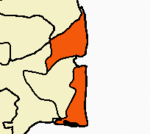|
Chudamani ViharaChudamani Vihara was a Buddhist vihara (monastery) in Nagapattinam, Tamil Nadu, India. Chudamani Vihara was constructed in 1006 CE[1] by the Srivijayan king Sri Vijaya Maravijayattungavarman with the patronage of Rajaraja Chola I.[2][3] The vihara building survived in dilapidated condition. Since 1856, about 350 Buddha bronzes have been found at Nagapattinam, dating from the 11th to the 16th century.[1] HistoryThe heritage of Nagapattinam is mentioned in the Burmese historical text of 3rd century B.C. which mentions a Buddha vihara built by the emperor Ashoka. The Anaimangalam copperplate of Kulothunga Chola I mentions that Kasiba Thera (Buddhist Monk) renovated the shrine in 6th century AD with the help of monks of "Naganadu" (Nagapattinam). The Pallava King Rajasimha (690–728) permitted a Chinese king to build Buddha vihara in Nagappattinam.[4] According to the copperplate record of Chola king Rajaraja, the Sailendra king, Sri Mara-vijayottunga-varman constructed the vihara with the support of Rajaraja. The copperplate is in Leiden University (Holland). [5] One statue, now at John D. Rockefeller Collection of Asian Art in New York, has an inscription that mentions that this Buddha was created to be carried in a procession during the temple’s sacred festival. The inscription has been translated by Vidya Dehejia as:
Notes
References
External links
|
